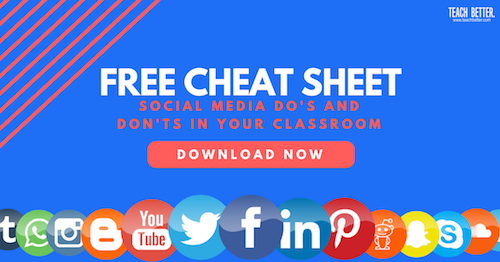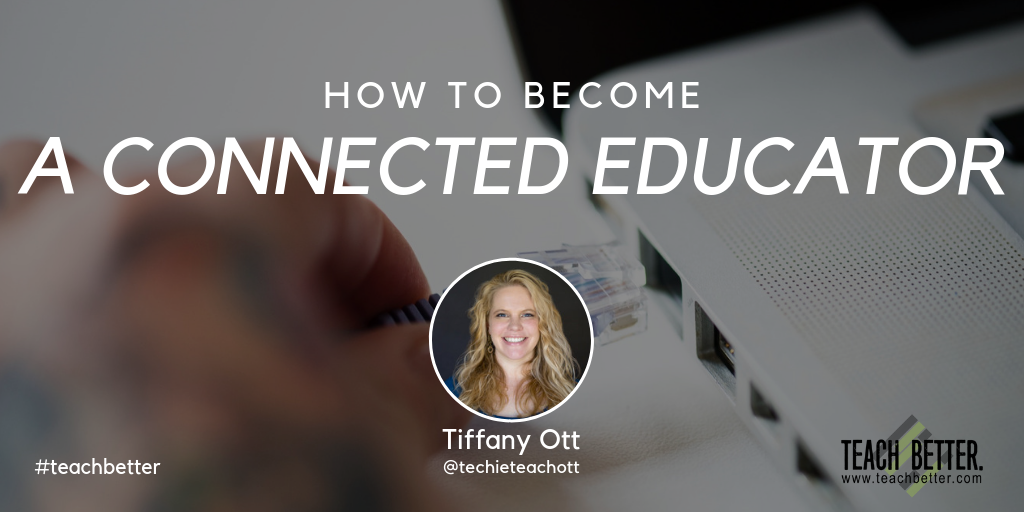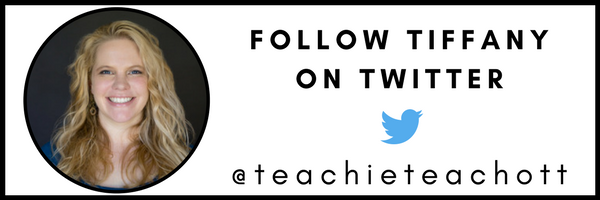In This Post:
- Connecting is what has moved humanity forward.
- Why becoming connected is the best decision you can make as an educator.
- Becoming a connected educator is not just about connecting on social media.
- There are many ways to be connected.
A Brief History Lesson
Whether you realize it or not, you’re lucky to be teaching right now at this moment in history. Throughout history, there have been a handful of events that have completely disrupted the status quo in human interaction, learning, and society- and we are living in one right now!
Without new ideas, challenges to our thinking, and different opinions, we will stagnate. Share on XLet’s look at some of the events that have led us to this super awesome moment in history.
- An agricultural revolution, launching across the globe in 10,000 BC, shifted humanity from a nomadic lifestyle to one of stationary communities. Now we can spend more time talking and thinking rather than picking berries!
- Between 5,000 and 2,000 BC, humans began to use symbols to represent ideas and letters, words, sentences, paragraphs, and more followed. The ability to share an idea with another person in a different area shifted humanity again- connecting us in ways never before imagined.
- The Gutenberg Press- a brilliant invention from the 1400’s that allowed books to be printed in mass quantities, rather than copied laboriously by individual monks, opened the world to the written word. It allowed, for the first time, the written word to be shared with the masses, rather than reserved for a handful of religious and political leaders. It launched the Renaissance and changed the human learning experience forever.
Which leads us to…
The 20th century! Complex machines with digital information storage ability burst into existence in the 30’s and 40’s and then into our homes with the advent of the personal computer in the 70’s and 80’s. Floppy disks and Oregon Trail made their way into schools and then, in what seemed like the blink of an eye, everything changed again.
The time? November, 1990. The place? The European Organization for Nuclear Research (CERN). The person? Tim Berners-Lee. The idea? A world-wide web accessed through computing devices and open to all. A portal for the sharing of information on a scale unimaginable for almost all of human history.
The internet arrived and changed everything. Within a decade, many schools in the country had internet connected computer labs. By the end of 2017, 94% of schools in America had high speed internet connections once they had sought out the best “internet providers in my area“, with the percent growing constantly through non-profit and government grant programs.
What a different world we live in now!
It is a different world for our students than it was for us. It is a different world today than it was just five years ago. And the journey we take as educators striving to be better for our students is different than it ever has been.
At no other time in the history of humanity has connecting with new ideas, education leaders, and an army of other educators, been easier. As teachers, we used to be limited to the people working in our district, the colleagues in our school, or the teacher down the hallway. Now, in an instant, we can hop on to social media and connect with educators across the globe who can support and challenge us and help us grow.
We are no longer alone.
Why you should connect
Our first year teaching is undeniably exhausting, but the growth we experience is amazing! We feed off of the knowledge, experience, and support of the educators around us- leaning on their expertise when we struggle. We try out new lessons and ideas, experimenting with how we want to define ourselves as a teacher. But then, something happens a few years into our career. We start to get comfortable in our classroom, in our subject, in our building. We know the routines and structures like the back of our hand and the content comes easily to us.
This is a dangerous place to be. I think Sylvia Duckworth (@SylviaDuckworth) sums it up beautifully with this image that often makes its way around Twitter.
When we settle into our routines as a teacher, and the new teacher insanity has calmed, we are at risk of two equally dangerous outcomes:
- Becoming bored
- Going out of date
Without new ideas, challenges to our thinking, and different opinions, we will stagnate. Worse? We will cling to habits and practices that simply do not support student learning. For a long time, we had to make do with an occasional new teacher in the building or a rare professional development day that actually showed us something new.
All that changed once we connected online.
Consider this. In the span of 30 seconds over my lunch break I can:
- Open Twitter on my phone.
- Tweet a question about how to manage student anxiety about testing.
- Tag some educators that I know on Twitter when I post the question.
Fast forward to the end of the school day and, lo and behold, there are 6 different comments on my post with responses ranging from:
“We use this stress reduction strategy you can find here: [link included in comment]”
“I do minimal test prep because of this stress. When I focus on teaching my students how to think, I worry less about fancy state tests- and so do they!”
“Ditto! I am struggling with this too. Help!”
Boom! Just like that, I have resources galore, ideas to try, and new people in my professional learning network to learn together with. That is the beauty of connection.
How to Connect
There are so many options for connecting better in the world we live in. Here are just 3 of them. Try one, try all three- just start somewhere and watch the awesomeness happen!
#1 Get yourself on social media.
Even if you avoid social media as a general rule, you should open an account if only for the purpose of connecting with educators. Feel free to keep your entire personal life off of it, but you will quickly find a vast expanse of amazing resources once you dive in and start exploring. Our favorites for educators are Twitter and Instagram.
Twitter is home to short bursts of information that can inspire you, links to resources about what is happening in the larger world of education, and Twitter Chats that can build your own personal PLN from the comfort of your couch. Spend some time exploring everything there is to offer by searching some of these common education hashtags (#edchat, #tlap, #teachbetter), then dive in on Thursday nights to #MasteryChat, our favorite chat of the week.
Follow everyone on the Teach Better Team here: Chad Ostrowski, Jeff Gargas, Rae Hughart, Tiffany Ott
Instagram is your source for visual inspiration and some incredibly dynamic educators giving you an inside peek into their amazing classrooms. Follow and learn from teachers that are doing incredible room transformations, engaging thematic units, getting through the day to day teaching routine with enthusiasm and style, and so much more!
Facebook is great for connecting with friends and family, but it is also really great for connecting with teachers! There are Facebook groups for everything from grade-specific concerns, subject-focused ideas, and general teaching inspiration. Here is a great list of 40 Facebook groups to start exploring- don’t forget to join the Teach Better Team group either!

#2 Really, really don’t want to go the social media route? Find yourself a mentor.
Maybe there is another teacher in your district that you have always looked up to. Do they have awesome parent communication skills? Are they frequently presenting at district PD days and always dropping nuggets of gold whenever they speak? Do they have a super engaging thematic unit that you want to learn more about? Just reach out!
Often, we hesitate to actually reach out to the people we admire, and we end up missing amazing learning opportunities. So hop on over to your email and send them a message. Ask if they can meet up for coffee and chat about what they do in their classroom. The worst that could happen? They can’t fit it into their schedule. The best? You could have a new education partner to learn with.
#3 Attend a conference.
There are so many amazing education conferences around the world that you can attend, and you might even be able to get your district to pay for the cost of getting you there. Have no fear, though, if your district is cutting spending and has put a freeze on approving any PD opportunities, there are also awesome local conferences for a much lower price point you can look into, and even free digital conferences open to anyone. DitchSummit is a great example of a digital conference done well.
Attending these conferences is a perfect opportunity to connect with other teachers striving to be better every day for their students. Many of them will also have networking events built into the schedule that you can use as a ready-made reason to talk to people you don’t know- and learn from them!
Finally, don’t be afraid to shine your own light and submit to present at a conference. Often, presenters get free or significantly reduced registration costs. Establishing yourself as a teacher with something to share helps others see you as open to connecting. Bonus? You get to learn together with the people in your sessions.
Whether it’s via social media, building a relationship with a mentor, or getting to a conference, get out there and connect! Find others who can support you, challenge you, and help you grow every day.
About Tiffany Ott
Tiffany Ott is the Director of Curriculum Development with the Teach Better Team and a high school math teacher in Ohio. Tiffany is also the founder of #MasteryChat and a educational technology fanatic.
As ten year veteran classroom teacher, she discovered a passion for meaningful technology integration. Now, she combines her love of great ed tech with a mastery learning approach to teaching and learning, transforming her class, her teaching, and her students’ learning, sharing her strategies with educators around the country.


